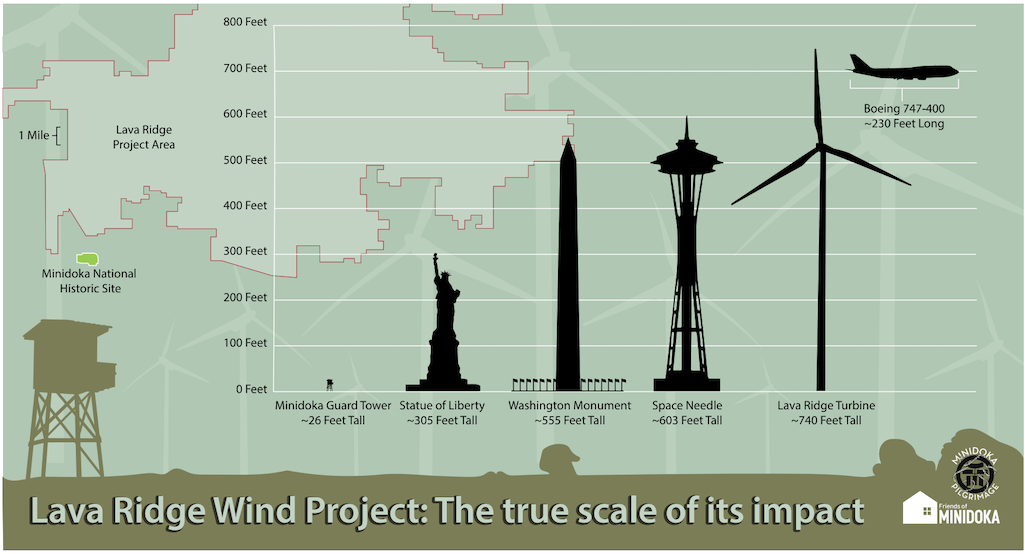
The proposed Lava Ridge Wind Farm would dwarf nearby Minidoka National Historic Site/Friends of Minidoka
Minidoka National Historic Site, a vestige of an ugly chapter of U.S. history when American citizens were incarcerated, is one of the country's most endangered historic places because of a massive wind turbine farm proposed to rise nearby on the windswept plains of southern Idaho.
During World War II thousands of "Issei," first generation Japanese-Americans and their families, were forced by the federal government in the wake of the attack on Pearl Harbor to be hauled by train into the scrublands of the Snake River Plain from Washington and Oregon for incarceration because of the perceived threat they posed to the United States during the war.
As the Traveler previously noted, today most of the historic fabric that depicted a repugnant chapter of U.S. history has been erased by time. To the south of the barracks stands an enormous root cellar the incarcerees built to hold the onions, carrots, corn, tomatoes, potatoes, radishes, cucumbers and other produce they grew on plots to the east of the dozens of barracks to feed themselves. Sadly, it is in a slow-motion state of collapse.
But the threat that landed Minidoka on the list of the country's top 11 most-endangered historic places compiled by the National Trust for Historic Preservation is a wind farm the U.S. Bureau of Land Management has been asked to allow to sprout from federal lands within two miles of Minidoka. The Lava Ridge project calls for up to 400 wind turbines standing taller than Seattle's 605-foot-tall Space Needle.
Minidoka’s sweeping vistas and distant mountains continue to convey the isolation and remoteness that Japanese Americans experienced there. However, a wind farm has been proposed next to Minidoka National Historic Site, potentially including construction of wind turbines within the historic footprint of the Minidoka camp. If constructed as currently planned, the project could irrevocably change Minidoka’s landscape, potentially creating a visual wall of hundreds of wind towers, each taller than the Seattle Space Needle, with blades exceeding the wingspan of a Boeing 747. -- National Trust for Historic Preservation.
“We are extremely disturbed by the proposed wind project and its disregard for the sacredness of Minidoka National Historic Site where 13,000 Americans of Japanese ancestry were unjustly incarcerated during World War II,” said Robyn Achilles, executive director for Friends of Minidoka, in response to the ranking. “Minidoka is a memorial to all those who suffered at the site. Survivors and their descendants make emotional pilgrimages to Minidoka where they remember, heal, and share stories to ensure these violations of civil liberties do not happen again. Minidoka is our past and our future.”



Comments
We need wind towers to save the planet, just as we needed to take extreme measures to save America during the War. Everybody endured hardships in that era, as they must now, for future generations.
in the 1940s, hundreds of thousands of American citizens were forced into camps, forced to fight in a war that they did not start, forced into deadly situations by their gov't, and often abandoned by that same gov't.
It was called THE MILITARY!
A WAR creates millions of tragedies, endless violence, injustice, atrocities, tragedies, crimes...it's highly inappropriate for us to judge the actions of those who were in the horrific middle of it from a mountaintop 80 years on. Calling this a " vestige of an ugly chapter" is simply wrong ,and stinks of presentism.
Yes, let's remember these events, study them, and try to understand it all.
But let's stop judging what happened in the 1940s from today's perspective.
Unfortunately, many NPS historic sites are interpreted (by the NPS) without regard to the way things were when the historic event occured. This may support the current culture, but distorts history. We have the benefit of seeing what happened since the historic event happened; the people who were there didn't have that advantage. Understanding why things happened the way they did is much more valuable than passing judgement on what happened.
Wow. Apologists for racism. I guess I should have seen that coming.
Y_P_W
read up on the "rape of nanking" and get back to me.. Also perhaps peruse the accounts of US civillians caught in Japan after they declared war on the US by bombing Pearl Harbor (alledgedly) without warning...
I am quite familiar with that and other atrocities committed by Imperial Japan. However, I fail to see how that could be used to justify imprisoning civilians residing in the United States, including US citizens who had no relationship with Imperial Japan.
I suppose then we should be able to imprison people based on past atrocities by their ancestors or perhaps descendants of their ancestors. Perhaps starting with the descendants of slaveowners.
Like I said, apologists for racism.